Description 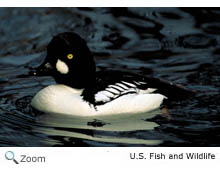 The common goldeneye is 16-20 inches in length with a wingspan of 30 inches. The male has a white body with a black back. His head looks black, but it is really a glossy green. In breeding season, he has an oval white patch on his face. The common goldeneye is 16-20 inches in length with a wingspan of 30 inches. The male has a white body with a black back. His head looks black, but it is really a glossy green. In breeding season, he has an oval white patch on his face.
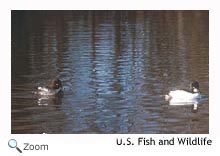 The female has a brown head and a white neck ring. She has gray wings, head, and tail and a grayish-white breast and belly. Both the male and female have short necks, round heads, golden eyes, a small black bill, and a white patch on their wings that is visible when they are in flight. The common goldeneye looks similar to Barrow's goldeneye, but the male Barrow's goldeneye has a crescent-shaped white mark on his face. The female has a brown head and a white neck ring. She has gray wings, head, and tail and a grayish-white breast and belly. Both the male and female have short necks, round heads, golden eyes, a small black bill, and a white patch on their wings that is visible when they are in flight. The common goldeneye looks similar to Barrow's goldeneye, but the male Barrow's goldeneye has a crescent-shaped white mark on his face.
Range 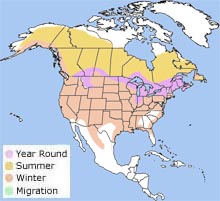 During breeding season, the common goldeneye
is found from Alaska across Canada and the northern most parts of the United States. It winters from southern Canada and Alaska throughout the United States south to Mexico. It is also found in Europe and Asia. During breeding season, the common goldeneye
is found from Alaska across Canada and the northern most parts of the United States. It winters from southern Canada and Alaska throughout the United States south to Mexico. It is also found in Europe and Asia.
| |
Habitat 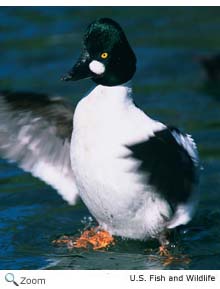 The common goldeneye is found in forested areas along lakes and rivers during breeding season. The prefer areas with mature forests where they can find plenty of cavities in trees for nesting. In the winter, the common goldeneye is found in bays and harbors and large inland lakes and rivers. They prefer areas with slow-moving, shallow water and stone, gravel, or sandy bottoms. The common goldeneye is found in forested areas along lakes and rivers during breeding season. The prefer areas with mature forests where they can find plenty of cavities in trees for nesting. In the winter, the common goldeneye is found in bays and harbors and large inland lakes and rivers. They prefer areas with slow-moving, shallow water and stone, gravel, or sandy bottoms.
Diet 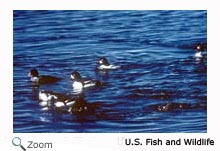 The
common goldeneye is a diving duck and eats mollusks, aquatic plants,
crustaceans, small fish, and insects. The
common goldeneye is a diving duck and eats mollusks, aquatic plants,
crustaceans, small fish, and insects.
Life Cycle  During courtship, the male stretches out his head over the water and then snaps it back over his back with his bill pointing up and calls out with a shrill cry. The female lays 8-12 pale green eggs in a tree cavity lined with down. Occasionally, she lays her eggs in the nest of another bird. The ducklings leave the nest when they are a few days old and can feed themselves. Young common goldeneyes sometimes form groups or crèches of ducklings from different broods. During courtship, the male stretches out his head over the water and then snaps it back over his back with his bill pointing up and calls out with a shrill cry. The female lays 8-12 pale green eggs in a tree cavity lined with down. Occasionally, she lays her eggs in the nest of another bird. The ducklings leave the nest when they are a few days old and can feed themselves. Young common goldeneyes sometimes form groups or crèches of ducklings from different broods.
Behavior
The wings of the common goldeneye make a whistling sound when they are in flight, and the common goldeneye is sometimes called the whistler.
|




 During breeding season, the common goldeneye
is found from Alaska across Canada and the northern most parts of the United States. It winters from southern Canada and Alaska throughout the United States south to Mexico. It is also found in Europe and Asia.
During breeding season, the common goldeneye
is found from Alaska across Canada and the northern most parts of the United States. It winters from southern Canada and Alaska throughout the United States south to Mexico. It is also found in Europe and Asia. 

